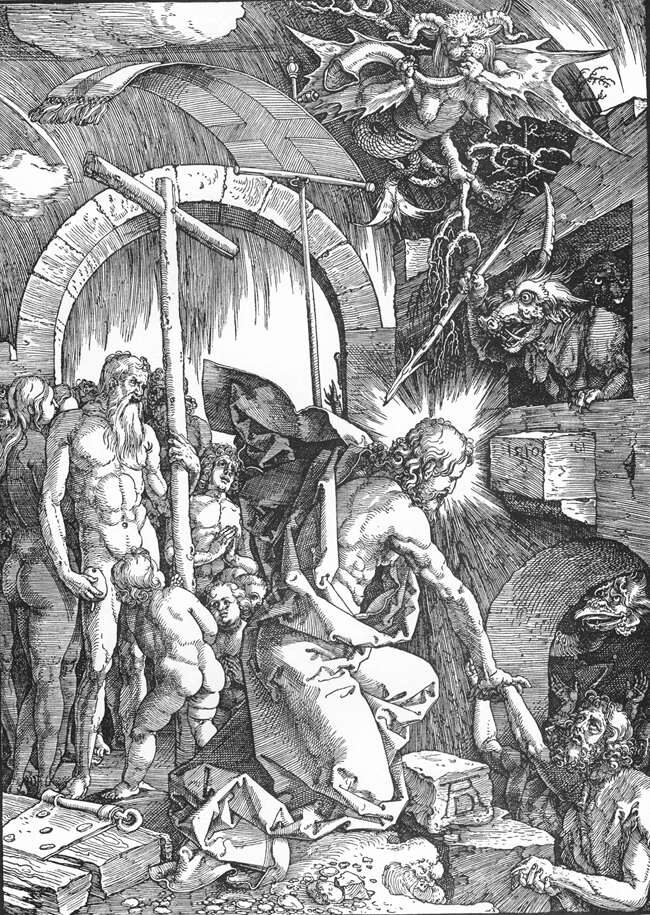Among the apocryphal writings that survived the silence of the centuries, few possess the dramatic depth of the Evangelium Nicodemi, also known as The Gospel of Nicodemus. Its second part, the Descensus ad Inferos, is one of the earliest Christian attempts to describe what occurred between the Crucifixion and the Resurrection, the hidden hours of Saturday, when the Light entered the realm of the dead.
This study opens a series of reflections on this text, beginning whilst the Sun travels through Scorpio, an accurate period to meditate upon it. It is the moment when Christ, astrologically represented by the Sun, plunges into the dark waters of Mars, mirroring the somber descent of the text.
Et cum exultarent sancti omnes, princeps et dux mortis dixit ad Inferum: Praepara temetipsum suscipere Iesum, qui gloriatur filium Dei esse, et est homo timens mortem, et dicens: Tristis est anima mea usque ad mortem. Et permulta adversatus est mihi male faciens; et multos quos ego caecos, claudos, surdos, leprosos et vexatos feci, ipse verbo sanavit; et quos ad te mortuos perduxi, hos ipse a te abstraxit.
—
And as all the saints rejoiced, the prince and captain of death said to Hell: Prepare thyself to receive Jesus, who boasts that He is the Son of God, and yet is a man who fears death, and says: My soul is sorrowful even unto death. He has done me much harm; for many whom I made blind, lame, deaf, leprous, and tormented, He has healed by His Word; and those dead whom I had brought to thee, He has snatched away from thee.

The present section examines the beginning of Chapter IV, where the Descent truly begins. Here, a symbolic inversion takes place: if Gabriel once announced to Mary the coming of the Light into the womb of the Virgin, now it is Satan who announces to the womb of Hell the coming of that same Light.
The fourth chapter of this apocryphal gospel marks the beginning of Christ’s Descent into Hades. Here occurs a symbolic inversion: if Gabriel once announced to Mary the coming of the Light into the womb of the Virgin, now it is Satan who announces to the womb of Hell the coming of that same Light.
This chapter also begins, in its first verse, with a cosmic irony. While sancti omnes exultant – the souls of the righteous rejoice – the voice that speaks is not theirs, but that of the princeps et dux mortis. This title doubles the infernal power: princeps (a spiritual ruler, a principality) and dux (a commander, a guide). It is a Roman form of military hierarchy transposed into the dominion of shadows.
He addresses the Inferus itself, which here is not merely a place, but an entity, the personified Hades. Praepara temetipsum suscipere Iesum – “prepare thyself to receive Jesus”. It is the first annunciation to the Darkness. Hell is warned that a man who “glories in calling himself the Son of God” is about to descend into it.
Satan here represents the mind that divides, the archetype of law without mercy. He calls himself “the prince of death” because he subsists on the rupture between God and man. When he speaks, he does so in a rational and accusatory tone. The following list of healings is an inventory of the redeemed powers: the blind (the intellect without light), the deaf (the soul that does not listen), the leprous (the body estranged from the Source), the vexed (the divided Spirit). Each healing was a subtraction from the empire of darkness. Verbo sanavit – “he healed by the Word” – means that the Word, the Logos dissolves the dogma of separation.
Thus the Descent into Hell is more than a simple battle between heaven and hell, but an act of inner reconciliation within Creation itself: Spirit penetrates matter in its densest form and compels the rebellious intellect to recognise the limit of its own sovereignty.
Κύριε ελέησον
